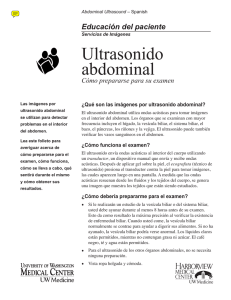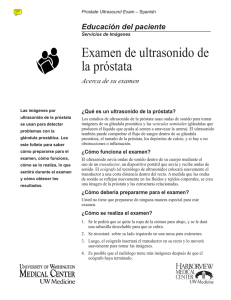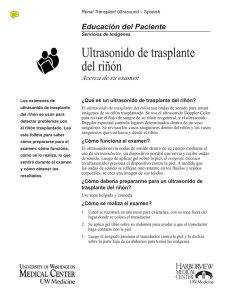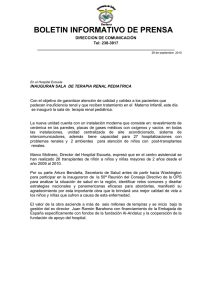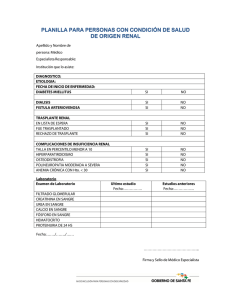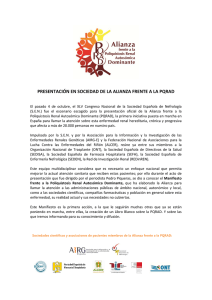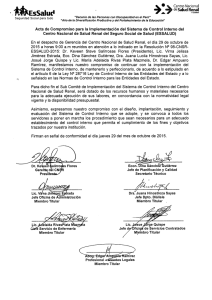Ultrasonido renal - Health Online
Anuncio
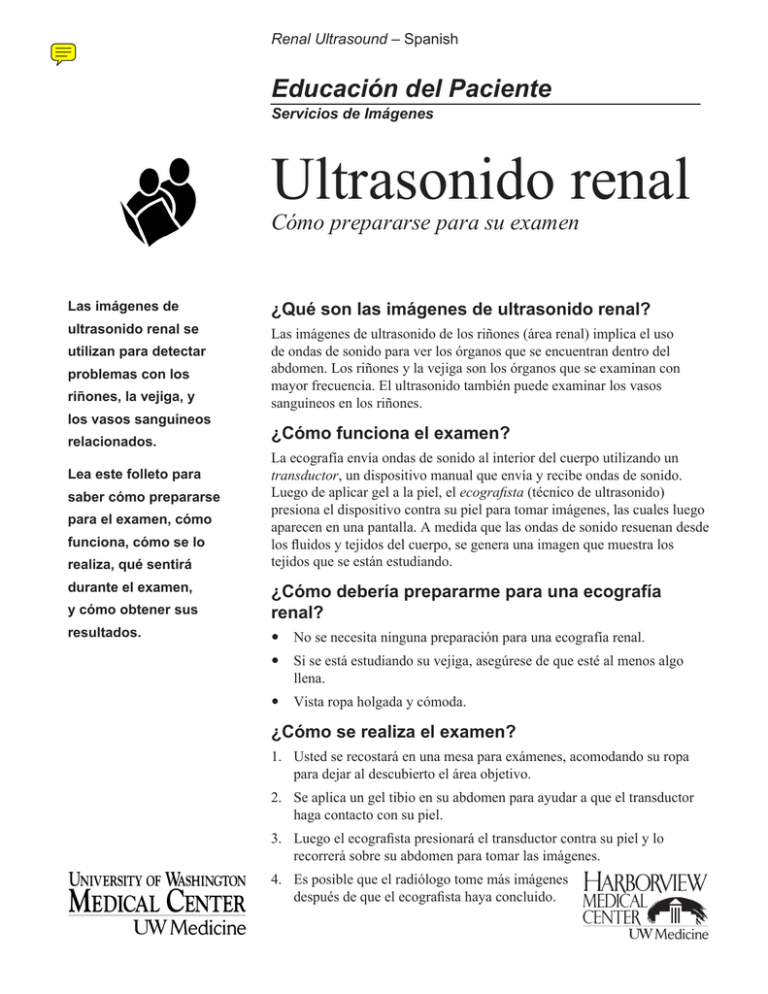
Renal Ultrasound – Spanish Educación del Paciente Servicios de Imágenes Ultrasonido renal Cómo prepararse para su examen Las imágenes de ultrasonido renal se utilizan para detectar problemas con los riñones, la vejiga, y los vasos sanguíneos relacionados. Lea este folleto para saber cómo prepararse para el examen, cómo funciona, cómo se lo realiza, qué sentirá durante el examen, y cómo obtener sus resultados. ¿Qué son las imágenes de ultrasonido renal? Las imágenes de ultrasonido de los riñones (área renal) implica el uso de ondas de sonido para ver los órganos que se encuentran dentro del abdomen. Los riñones y la vejiga son los órganos que se examinan con mayor frecuencia. El ultrasonido también puede examinar los vasos sanguíneos en los riñones. ¿Cómo funciona el examen? La ecografía envía ondas de sonido al interior del cuerpo utilizando un transductor, un dispositivo manual que envía y recibe ondas de sonido. Luego de aplicar gel a la piel, el ecografista (técnico de ultrasonido) presiona el dispositivo contra su piel para tomar imágenes, las cuales luego aparecen en una pantalla. A medida que las ondas de sonido resuenan desde los fluidos y tejidos del cuerpo, se genera una imagen que muestra los tejidos que se están estudiando. ¿Cómo debería prepararme para una ecografía renal? • • No se necesita ninguna preparación para una ecografía renal. • Vista ropa holgada y cómoda. Si se está estudiando su vejiga, asegúrese de que esté al menos algo llena. ¿Cómo se realiza el examen? 1. Usted se recostará en una mesa para exámenes, acomodando su ropa para dejar al descubierto el área objetivo. 2. Se aplica un gel tibio en su abdomen para ayudar a que el transductor haga contacto con su piel. 3. Luego el ecografista presionará el transductor contra su piel y lo recorrerá sobre su abdomen para tomar las imágenes. 4. Es posible que el radiólogo tome más imágenes después de que el ecografista haya concluido. Servicios de Imágenes Ultrasonido renal ¿Preguntas? Sus preguntas son importantes. Si tiene preguntas o inquietudes, llame a su médico o proveedor de atención a la salud. El personal de la clínica también se encuentra disponible para ayudar. q Servicios de Imágenes de UWMC: 206-598-6200 q Servicios de Imágenes de Harborview: 206-744-3105 UWMC Imaging Services Box 357115 1959 N.E. Pacific St. Seattle, WA 98195 206-598-6200 ¿Qué sentiré durante el examen? • • La ecografía de los riñones es rápida, indolora y fácil. • Es posible que se le pida que se recueste sobre uno de sus lados, o que cambie de posición. • Usted sentirá que el ecografista aplica gel tibio a su abdomen y presiona el transductor contra su piel. El dispositivo se desplazará sobre su piel hasta tomar todas las imágenes. Hay muy poca o ninguna incomodidad con el examen. El examen normalmente toma menos de 45 minutos. ¿Quién interpreta los resultados del examen y cómo los obtengo? El radiólogo, quien se especializa en ultrasonido, revisará las imágenes y enviará el informe a su médico referente. Usted recibirá sus resultados del médico que ordenó el examen. En algunos casos, es posible que el radiólogo converse con usted acerca de algunos resultados preliminares al finalizar el examen. © University of Washington Medical Center Renal Ultrasound Spanish 03/2005 Rev. 05/2009 Reprints: Health Online Patient Education Imaging Services Renal Ultrasound How to prepare for your exam Renal ultrasound imaging What is renal ultrasound imaging? is used to detect problems and related blood vessels. Ultrasound imaging of the kidneys (renal area) involves using sound waves to see the organs inside the abdomen. The kidneys and bladder are the organs examined most often. Ultrasound can also examine the blood vessels in the kidneys. Read this handout to learn How does the exam work? how to prepare for the Ultrasound imaging sends sound waves into the body using a transducer, a hand-held device that sends and receives sound waves. After gel is applied to the skin, the sonographer (ultrasound technologist) presses the device against your skin to take pictures, which then appear on a screen. As the sound waves echo from the body’s fluids and tissues, an image is created showing the tissues that are being studied. with the kidneys, bladder, exam, how it works, how it is done, what you will feel during the exam, and how to get your results. How should I prepare for a renal ultrasound? • No preparation is needed for a renal ultrasound. • If your bladder is being studied, make sure it is at least somewhat full. • Wear loose-fitting, comfortable clothes. How is the exam done? 1. You will lie on an exam table, with your clothing moved away from the target area. 2. A warm gel is applied to your abdomen to help the transducer make contact with your skin. 3. The sonographer will then press the transducer against your skin and sweep it over the abdomen to take the pictures. 4. The radiologist may take more pictures after the sonographer is done. Imaging Services Renal Ultrasound What will I feel during the exam? Questions? Your questions are important. Call your doctor or health care provider if you have questions or concerns. Clinic staff are also available to help. UWMC Imaging Services: 206-598-6200 Harborview Imaging Services: 206-744-3105 • Ultrasound imaging of the kidneys is fast, painless, and easy. • You will feel the sonographer apply warm gel to your abdomen, and press the transducer against your skin. The device will be moved over your skin until all the pictures are taken. • You may be asked to roll on either side, or to change positions. • There is little or no discomfort with the exam. The exam usually takes less than 45 minutes. Who interprets the results of the exam and how do I get them? The radiologist, who specializes in ultrasounds, will review the pictures and send the report to your referring doctor. You will receive your results from the doctor who ordered the test. In some cases, the radiologist may discuss early findings with you at the end of your exam. __________________ __________________ __________________ __________________ UWMC Imaging Services Box 357115 1959 N.E. Pacific St. Seattle, WA 98195 206-598-6200 © University of Washington Medical Center 03/2005 Rev. 05/2009 Reprints: Health Online
